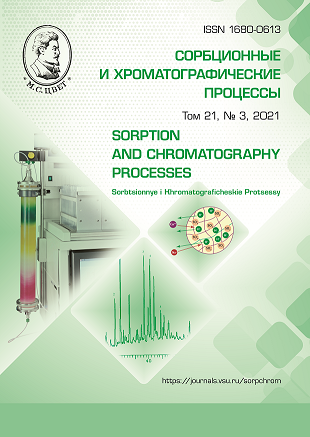Study of sorption properties of carboxylated carbon nanotubes on a baw-type piezo micobalance
Abstract
The features of the sorption of vapours of individual highly volatile organic compounds of various classes on the phases of carboxylated carbon nanotubes (MWNT-соон). The peculiarity of the study was the use of a sorption phase of small masses (from 1 to 5 μg) and direct weighing of adsorbates of vapours of substances at any moment of sorption by highly sensitive piezo balances with a sensitivity of up to 10-12 g. The dependence of the efficiency of sorption by the phase from MWNT-соон to vapours of the selected compounds (alcohols, ketones, acids, arenes) on the mass of the applied phase on a limited surface area. This approach to the formation of a layer of tubes allows one to obtain a surface and porosity of different structure, which determines the selectivity of vapour sorption. Calculations of sorption isotherms of compounds, allowing either to fix them highly selectively in a mixture or to estimate the change in concentration are presented. It was found that for the same sorbtive, the shape of the sorption isotherm on phases of different masses changes from linear to S-shaped. Therefore, it is impossible to describe the curves with a single theory. The maximum capacity of the monolayer to acetone molecules and the minimum capacity to phenol vapours were established. Carboxylated nanotubes absorb aliphatic alcohols of normal and isomeric structure in different ways, butyl and pentyl alcohols are distinguished by the sorption characteristics. Mass-sensitive piezoelectric sensors with MWNT-соон of different masses are recommended as measuring elements for gas analysers and systems for the integral assessment of complex mixtures of compounds of low concentrations with the "electronic nose" methodology. The application in one array of sensors with MWNT-соон increases the selectivity of the detection of components in the mixture at the level of microconcentrations without separation.
Downloads
References
Mcginley C.M., Mcginley M.A., Air & Waste Management Association Specialty Conference: Odors and Air Emissions, Hart-ford, 2006, pp. 9-12.
Kuchmenko T.A. Himicheskie sensory na osnove p'ezokvarcevyh mikrovesov, V monografii Problemy analiticheskoj himii, Pod red. Ju.G. Vlasova, 2011, Vol. 14, pp. 127-202.
Kornev A.S., Rossijskij himicheskij zhurnal, 2011, Vol. 112, No 6, pp. 94-101.
Vasil'ev A.A., Pavlenko R.A., Se-vast'janov V.A., RZh 19BD, 2008, No 15, pp. 53.
Shogenov Ju.H., Kuchmenko T.A., Gra-zhulene S.S., Red'kin A.N., Zhurnal analit-icheskoj himii, 2012, Vol. 67, No 1, pp. 12-18.
Kuchmenko T., Umarkhanov R., Lvova L., Sensors and Actuators, B: Chemical, 2020, Vol. 322.
https://doi.org/10.1016/j.snb.2020.128585
Rajneesh M., Meetu B., Manmeet K., Kailasa G. et al., BARC Newslett, 2009, No 297, pp. 240-245.
Kuchmenko T.A., Umarhanov R.U., Zhurnal analiticheskoj himii, 2013, Vol. 68, No 4, pp. 397-405.
Obirai Joseph C., Hunter Gary, Dutta Prabir K., Sens. and Actuators. B, 2008, Vol. 134, No 2, pp. 640-646.
Kuchmenko T.A., Umarhanov R.U., KochetovaZh.Ju., Bel'skih N.V., Zhurnal analiticheskoj himii, 2012, Vol. 67, No 11, pp. 1032.
Kuchmenko T.A. Innovacionnye resh-enija v analiticheskom kontrole, Voronezh, VGTA, 2009, 252 p.
Kuchmenko T.A., Selmanshhuk V.A. Patent RF, No 2327984, 2008.
Kuchmenko T.A., KorenmanYa.I., Trivunac K.V., Rajakovič L.V., J. of Analyt. Chem., 1999, Vol. 54, No 2, pp. 161-165.
Kuchmenko T.A., Shuba A.A., Bel'skih N.V., Analitika i kontrol', 2012, Vol. 16, No 2, pp. 151-161.







